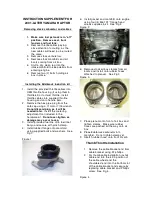
#
Ensure that the driven speed complies
with traffic regulations.
#
Adjust the driving speed to suit current
traffic and weather conditions.
▌
Function of route-based speed adaptation
When Active Distance Assist DISTRONIC is activa-
ted, the vehicle speed will be adapted accordingly
to the route events ahead. Depending on the drive
program selected, the vehicle negotiates a route
event ahead in an energy-saving, comfortable or
dynamic manner. When the route event has been
passed, the vehicle accelerates again to the
stored speed. The set distance to the vehicle in
front, vehicles detected ahead and speed restric-
tions ahead are taken into account.
Route-based speed adaptation can be activated in
the multimedia system (
/
page 341).
The following route events are taken into account:
R
Bends
R
Roundabouts
R
T-junctions
R
Turns and exits
R
Traffic jams ahead (only with Live Traffic
(
/
page 525))
Also, the speed is reduced if the turn signal indi-
cator is switched on and one of the following sit-
uations is detected:
R
Turning off at junctions
R
Driving on slowing-down lanes
R
Driving on lanes adjacent to slowing-down
lanes
The driver is responsible for choosing the right
speed and observing other road users. This
applies in particular to junctions, roundabouts and
traffic lights, as route-based speed adaptation
does not brake the vehicle to a standstill.
If a corresponding route event is detected while
route guidance is active, the first speed adjust-
ment is carried out automatically. If the turn signal
indicator is switched on, the selected route is
confirmed and further speed adjustment is activa-
ted.
Speed adaptation is cancelled in the following
cases:
R
If the turn signal indicator is switched off
before the route event and it is therefore
assumed that the route event is not relevant
to the driver.
R
If the driver depresses the accelerator or
brake pedal during the process.
System limits
Route-based speed adaptation does not take right
of way regulations into account. The driver is
responsible for complying with road traffic regula-
tions and driving at a suitable speed.
In difficult conditions, the speed selection made
by the system may not always be suitable. This
applies to the following situations, forexample:
R
unclear roads
R
Road narrowing
R
varying maximum permissible speeds in indi-
vidual lanes, forexample at toll stations
R
wet road surfaces, snow or ice
R
if transport equipment, forexample a trailer or
bicycle rack, is attached to the trailer hitch
340 Driving and parking
ohne
Summary of Contents for EQS 2021
Page 1: ...EQS Operator s Manual ohne...
Page 61: ...ohne...
Page 62: ...Left hand drive vehicles with central display 60 At a glance Cockpit central display ohne...
Page 64: ...Left hand drive vehicles with MBUX hyperscreen 62 At a glance Cockpit MBUX Hyperscreen ohne...
Page 66: ...Standard driver display 64 At a glance Indicator and warning lamps standard ohne...
Page 70: ...68 At a glance Overhead control panel ohne...
Page 72: ...70 At a glance Door operating unit and seat adjustment ohne...
Page 74: ...72 At a glance Control settings in the rear passenger compartment ohne...
Page 76: ...74 At a glance Emergencies and breakdowns ohne...
Page 925: ...ohne...
Page 926: ...ohne...
















































